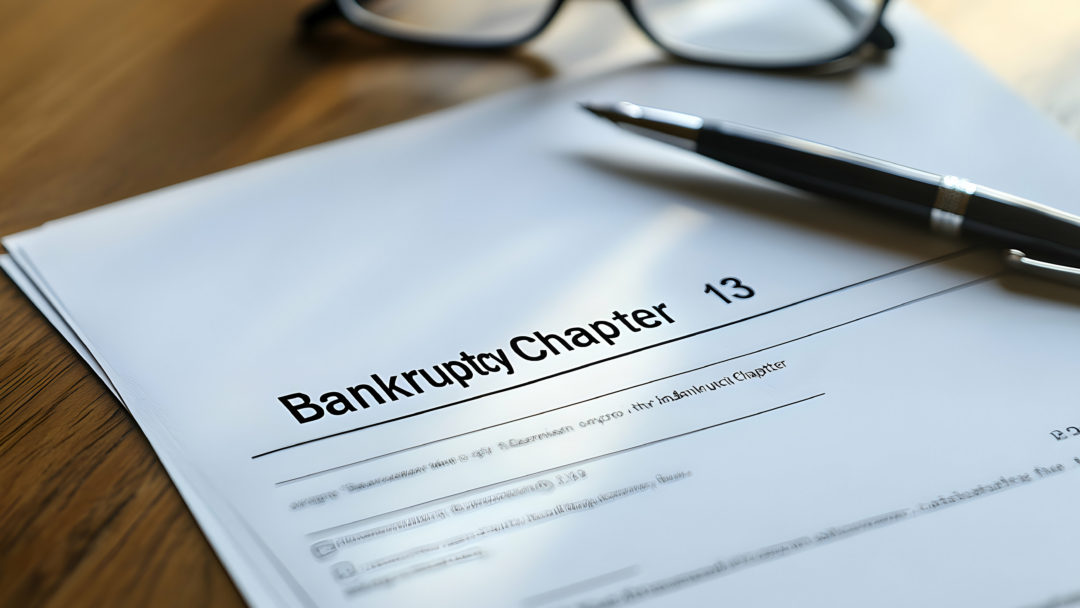Bankruptcy
- Bankruptcy Basics: Process to manage or eliminate debt through elimination, restructuring, or repayment plans.
- Types: Chapter 7 (debt discharge), Chapter 11 (business restructuring), Chapter 13 (repayment plans).
- Downsides: Affects credit, doesn’t cover all debts, may require asset liquidation, and limits future opportunities.
- Filing: Involves credit counseling, court filings, and trustee oversight; legal help is advised.
- Alternatives: Debt consolidation, settlement, and credit counseling offer non-bankruptcy options.
Free Consultation with a Certified Debt Specialist
Start with a Free No-Obligation Consultation

See if you qualify for debt relief!
What is Bankruptcy?
Bankruptcy is a legal process that can help individuals, businesses, towns and even farmers get relief from overwhelming debt. It offers a variety of solutions depending on the specific situation. Bankruptcy can eliminate some or all of the debt, restructure it for easier management, or create a manageable payment plan. The first step to get started is filing a petition in bankruptcy court.
The Downsides of Filing for Bankruptcy
While bankruptcy may offer a lifeline from debt, it does have a few downsides. Here are some of the key challenges:
- Financial Costs: Bankruptcy isn’t free. Expect court fees, attorney costs and the possibility of selling assets like your car or house to repay creditors.
- Lingering Debts and Obligations: Federal student loans, child support and certain taxes still remain your responsibility after bankruptcy.
- Legal and Credit Score Damage: Providing false information during filing may lead to legal trouble. Bankruptcy can stay on your credit report for up to 10 years.
- Long-term Impact: Renting an apartment or getting a mortgage may become more difficult. Certain jobs may become off-limits. Car insurance premiums are likely to rise.
- Loss of Control and Time Commitment: The court may manage your assets even after discharge. Chapter 13 bankruptcy involves a multi-year repayment plan.
- Irreversible Decision: Bankruptcy is a permanent step. Consider credit counseling first to determine if it’s the right path for you.
Bankruptcy Statistics
- Both personal and business bankruptcy filings saw a 10% increase for the twelve months ending on June 30, 2023, compared to the prior year.
- 15,724 business and 403,000 non-business bankruptcies were filed in 2023
- The most common types of bankruptcy over the last five years were Chapter 11 for businesses and Chapters 7 and 13 for personal bankruptcies.
- Since the early 1990s, bankruptcy filings by people 65 and older have tripled.
- The number of people filing for bankruptcy aged 55 and older has doubled in the past 16 years. This age group now represents 20% of all bankruptcy filings.
Why People Might Require Bankruptcy
The Many Paths to Bankruptcy
Financial hardship can strike from many sides and bankruptcy sometimes becomes the only way out. Here are some of the most common reasons people file:
- Job Loss: Without a paycheck, bills add up and savings disappear.
- Medical Bills: Even with insurance, medical emergencies can cause overwhelming debt.
- Unaffordable Mortgages: High mortgage payments or rising interest rates can lead to bankruptcy.
- Credit Card Debt: High interest rates and overspending can make credit card debt difficult to manage.
- Divorce: Legal fees, alimony and maintaining two households can be a financial burden.
- Failed Debt Management: Sometimes attempts to manage debt, like consolidation loans, fail.
- Unexpected Events: Natural disasters or other unforeseen events can lead to high costs and bankruptcy.
Types of Bankruptcy
Three Main Types of Bankruptcy
This comparison chart highlights the main features of the three most common types of bankruptcy
| Feature | Chapter 7 | Chapter 11 | Chapter 13 |
| Purpose | Eliminate most debts for individuals | Reorganize businesses to stay operational | Create repayment plans for individuals |
| Eligibility | Individuals meeting the income means test | Primarily businesses with high levels of debt | Individuals with steady income & debt limits |
| Debt Repayment | Debt elimination (discharge) for most debts | Repayment plan | Structured repayment plan over 3-5 year |
| Asset Liquidation | May require selling some non-essential assets | May require selling some assets | Protects most assets from repossession |
| Credit Counseling | Required within 180 days of filing | Required within 180 days of filing | Required within 180 days of filing |
| Impact on Credit | Stays on credit report for 10 years | Stays on credit report for 10 years | Stays on credit report for 7 years |
| Timeline | Relatively quick (4-6 months) | Can be lengthy and complex | Typically 3-5 years |
Chapter 7
Chapter 7 bankruptcy is a legal process that allows individuals to wipe out most unsecured debts like credit cards and medical bills, offering a fresh financial start. Known as liquidation bankruptcy, it’s the fastest and most common form of bankruptcy.
Eligibility
To be eligible to file for Chapter 7 bankruptcy, you must:
- Take a credit counseling course within the last 180 days.
- Wait the required time since any past bankruptcy filings (usually 6-8 years).
- Pass the means test, which checks income and eligibility based on your state’s median income.
- Be truthful in your application; hiding assets can disqualify you.
How It Works
Chapter 7 bankruptcy eliminates some debts (credit cards, medical bills) but not others (student loans, child support). You may sell some assets to repay creditors, but essentials are protected. The process involves paperwork, credit counseling and potential court appearances. It’s publicly recorded and may limit your financial control temporarily.
How to File
While you can technically file for Chapter 7 bankruptcy yourself, hiring an experienced attorney is recommended to maximize your chances of success. Here’s a quick breakdown of the process:
- Gather financial documents (income, assets, debts).
- Take a credit counseling course (usually within 6 months).
- Pass the means test to prove eligibility.
- File a petition with the court (fees apply).
- Meet a trustee who reviews your finances.
- Attend a creditors’ meeting to answer questions.
- Complete a debtor education course.
- Receive a debt discharge (elimination of qualifying debts) upon court approval.
Things to Avoid Before Filing
Here are some things to avoid before filing for bankruptcy:
- Favoring Any Creditors: Making large payments to just one creditor before filing isn’t recommended.
- Racking Up New Debt: Taking on new debt shortly before filing may look suspicious.
- Making Unusual Money Moves: Don’t transfer assets, buy luxuries or remove yourself from a business right before filing.
- Being Dishonest: Disclose all your finances accurately and completely.
- Tapping Retirement Savings: Try to avoid using retirement savings to pay down debt before filing.
- Filing Prematurely: Wait to file if you expect a financial windfall that could solve your debt problems.
- Going It Alone: Consult with a lawyer to avoid jeopardizing your case.
Covered Debt
Chapter 7 bankruptcy eliminates most common debts such as credit cards, medical bills, personal loans and deficiencies from repossessions. It can also discharge utility bills, court judgments and government benefit overpayments. However, child support, student loans, most taxes, HOA fees in some cases and debts from fraud or drunk driving accidents cannot be eliminated.
What to Do After Chapter 7
Chapter 7 bankruptcy can be a fresh start, especially when paired with a new approach to money. Consider making a budget to track your income and spending. Sticking to your budget may help you avoid unnecessary spending and start to rebuild savings. Paying all your bills on time can help establish responsible financial habits. Rebuilding after bankruptcy takes time, but with a change in mindset and some guidance, you can achieve a brighter financial future.
Chapter 11
Chapter 11 bankruptcy, sometimes called reorganization bankruptcy, offers businesses a chance to hit the pause button and rework their finances. Businesses can typically stay operational throughout the process. Chapter 11 bankruptcy is also available to certain individuals with significant debt after ruling out Chapter 7 and Chapter 13 bankruptcy options.
Eligibility
Who can file for Chapter 11 bankruptcy?
- Businesses: Small and large businesses can use Chapter 11 to restructure their finances while staying operational.
- Individuals With Very High Debt: If personal debts exceed the limits for Chapter 13 bankruptcy, Chapter 11 might be an option. It may be cheaper than Chapter 13 in some cases.
- Creditors (involuntary filing): In rare instances, creditors owed a significant amount of money can force you into Chapter 11 if you’re not meeting your repayment obligations.
How It Works
Chapter 11 bankruptcy offers struggling businesses a chance to restructure debt and stay afloat. The business files a petition outlining its finances and a repayment plan in bankruptcy court. A court-appointed manager oversees the company while creditors assess the plan. If approved by the court and a majority of creditors, the business can begin repaying debt under the new terms.
How to File
Filing for Chapter 11 bankruptcy involves several steps:
- Petition and Documents: File a petition in bankruptcy court with financial statements, income details and debt lists. Additional requirements apply to individuals.
- Credit Counseling: Complete credit counseling within the last 180 days (fees apply).
- Debtor in Possession: The business usually stays operational while managing assets under court protection.
- Reorganization Plan: Create a court-approved plan outlining how creditors will be repaid.
- Creditor Vote: Creditors vote on the plan. If approved, the court finalizes it, allowing the business a fresh start.
Things to Avoid Before Filing
Here’s what to avoid before filing for Chapter 11 bankruptcy:
- Messy Records: Keep detailed financial records for a smooth reorganization process.
- No Plan: Develop a realistic repayment plan with a clear path to profitability.
- Running Out of Money: Chapter 11 is expensive. Ensure you have enough funds to cover legal fees and specialists.
- Expecting a Quick Fix: Chapter 11 takes time. Be prepared for negotiations and revisions.
- Ignoring Creditors: Communicate openly and honestly with creditors to avoid objections.
Covered Debt
Chapter 11 bankruptcy focuses on restructuring debt, not elimination. Unlike other bankruptcies, the goal is to create a repayment plan for creditors.
- Some exceptions remain, like student loans and back taxes, but the plan must address how they’ll be repaid.
- The plan dictates how remaining debts are handled: partial repayment, full repayment over time or even discharge in specific situations.
- Repayment plans typically last 5 years, with a 10-year maximum for complex cases.
What to Do After Chapter 11
Chapter 11 lets your business operate but with some limitations:
- For the most part, you can run business as usual, selling inventory and buying supplies.
- Selling major assets or entering new leases requires court approval.
- Hiring professionals to help with the bankruptcy needs court approval.
- Regular financial reports are mandatory to keep the court informed.
Chapter 13
Chapter 13 bankruptcy is an option for individuals with a regular income to manage their debt and get a fresh financial start. Also known as a wage earner’s plan, it lets people create a repayment plan lasting 3-5 years to pay back creditors in a structured way.
Eligibility
To qualify for Chapter 13 bankruptcy:
- Your total debt (secured and unsecured) must be under the current limit ($2,750,000).
- You can’t have had a recent bankruptcy dismissal due to court order violations.
- You need credit counseling from a government-approved agency within the last 180 days.
- You may need to include a debt management plan with your filing.
How It Works
Chapter 13 bankruptcy creates a manageable debt repayment plan for individuals with steady incomes. Unlike Chapter 7 (asset liquidation), Chapter 13 lets you keep your property. You develop a 3 to 5-year plan to repay creditors, prioritizing secured debts like mortgages. You may potentially eliminate unsecured debts like credit cards. To qualify, you need a steady income, must be under debt limits, and current on taxes. When your plan is approved, you make payments and keep your assets.
How to File
Filing for Chapter 13 bankruptcy involves these steps:
- File a Petition: Submit a petition to the bankruptcy court with financial documents (lists of creditors, income, expenses, assets). Fees apply, but installment payments might be an option.
- Trustee and Automatic Stay: A trustee oversees your case and distributes payments. Filing triggers an automatic stay, which stops most creditor collection actions (consult a lawyer for exceptions).
- Develop a Repayment Plan: Create a 3 to 5-year plan detailing your monthly payments based on your finances. Discuss it with the trustee and creditors at a meeting.
- Plan Confirmation and Repayment: The court approves your plan and you start making monthly payments to the trustee for distribution to creditors.
Things to Avoid Before Filing
Here’s what to avoid before filing for Chapter 13 bankruptcy:
- New Debt: Avoid creating more debt before filing. If you do, creditors may object to your repayment plan.
- Asset Transfers: Don’t give away assets to avoid bankruptcy. This could be considered fraud.
- Skipping Steps: Complete credit counseling and gather tax returns (past year or more).
- Inaccurate info: Ensure all filing information is complete and accurate. Consult a lawyer if needed.
- Missing Court: Show up for court appearances and meet deadlines.
- Creditor meeting: Attend the meeting and answer questions about your finances and plan.
- Missed Payments: Make your monthly payments on time after your plan is approved. Missing payments can lead to dismissal and loss of protection.
Covered Debt
Chapter 13 prioritizes debt repayment:
- Priority Debts (child support, taxes): Must be repaid in full.
- Secured Debts (mortgages, car loans): The repayment plan must cover missed payments and ongoing payments to keep the property.
- Unsecured Debts (credit cards, medical bills): Paid with leftover income after essentials and secured debt payments. The remaining debt may be eliminated after the plan.
- Chapter 13 Trustee Fee: An additional 10% fee is added to your plan payments.
What to Do After Chapter 13
After your Chapter 13 plan is complete, here are some important steps to take:
- Confirm Discharged Debts: Consult with a lawyer to understand which debts are eliminated through the discharge.
- Get Proof of Completion: Obtain documentation of your completed financial management course.
- Wait for Discharge Order: The court will formally discharge your debts after a hearing.
- Review Credit Report: Check your credit report to ensure discharged debts are reflected accurately. Dispute any errors.
- Build Healthy Financial Habits: Practice responsible financial management to avoid future debt problems.
What happens when you declare bankruptcy?
Declaring bankruptcy is a serious decision with significant consequences. Here’s a quick rundown of what to expect:
- Debt Relief: Bankruptcy can help you get a fresh start financially. You may repay some of your debts over time or eliminate them.
- Protection From Creditors: Filing for bankruptcy triggers an automatic stay, which stops creditors from contacting you for payments. This includes wage garnishments and seizing your assets.
- Types of Bankruptcy: There are two main types for individuals: Chapter 7 and Chapter 13.
- Chapter 7: Assets are sold to repay creditors. Some assets are exempt, such as your home equity and car (up to a certain value). This option is generally chosen by those with lower incomes and fewer assets. You’ll need to pass a means test to qualify.
- Chapter 13: You create a repayment plan (3-5 years) to repay creditors while keeping your assets. This is chosen by those with a steady income who want to keep their property or avoid foreclosure.
- Steps Involved: The process includes consulting an attorney, attending credit counseling, filing a petition with the court, listing your debts and potentially having a trustee appointed to manage your case.
- Debt Discharge: After meeting the requirements of your chosen chapter, the court will issue a discharge order, eliminating your legal obligation to repay most debts (excluding child support, student loans, and certain taxes).
- Impact on Credit: Bankruptcy stays on your credit report for 7-10 years. Using credit responsibly after bankruptcy may demonstrate a positive change in your financial behavior. This can help improve your chances of getting approved for credit cards, loans, or mortgages in the future.
Bankruptcy Alternatives
Bankruptcy offers debt relief but remains on your credit report for up to 10 years, making renting an apartment, securing loans and even getting a job more challenging. Let’s look at some alternative strategies that may help you manage your debt without the long-term burden of bankruptcy.
Debt Settlement
Debt settlement is a bankruptcy alternative aimed at people struggling with overwhelming debt. It involves a debt settlement company negotiating with creditors to lower your debt amount in exchange for a lump sum payment.
Pros:
- Potentially Significant Debt Reduction: You may settle your debts for a fraction of what you owe.
- Reduced Stress From Creditor Calls: The company negotiates with creditors on your behalf, stopping collection calls.
- Faster Payoff Than Making Minimum Payments: By stopping regular payments, funds are accumulated for a quicker payoff.
Cons:
- Fees: Debt settlement companies may charge 15-25% of the settled debt.
- Credit Score: Stopping payments may hurt your credit score due to missed payments and potential account closures.
- Not Guaranteed: Creditors aren’t obligated to accept settlements.
- Tax Implications: Settled debt over $600 is considered taxable income.
Who should consider debt settlement?
Debt settlement is an option for individuals with overwhelming unsecured debt seeking significant debt reduction and a faster payoff.
Debt Consolidation
Debt consolidation is a strategy for people facing high-interest debt who haven’t missed payments and have fair to good credit. It aims to simplify your debt by combining it into one payment with a lower interest rate.
Pros:
- Lower Interest Rates: You may replace high-interest credit card debt with a lower interest loan or balance transfer card, saving money in the long run.
- Simpler Management: Consolidating debt simplifies finances by having one monthly payment instead of juggling multiple creditors.
- Potential Credit Improvement: Using your credit cards less and having a variety of loans (like car payments) that you repay on time can improve your financial standing.
Cons:
- Temptation to Overspend: Consolidation can free up credit on existing cards, tempting you to spend and create new debt.
- Potential Fees: Balance transfer cards often have upfront fees for transferring balances. Personal loans may have origination fees.
Who should consider debt consolidation?
Debt consolidation is ideal for individuals with fair to good credit struggling with high-interest debt who can manage a fixed monthly payment. It’s important to have the discipline to avoid adding new debt to the cards you’ve paid down.
Credit Counseling
Credit counseling is a free or low-cost resource for anyone facing mounting debt, regardless of credit score. It’s a good first step before considering options like debt settlement.
Pros:
- Free or Low-Cost Financial Advice: Credit counseling agencies offer professional guidance about budgeting and debt management at little to no cost.
- Personalized Debt Repayment Plan: Counselors may work with you to create a realistic budget and plan to tackle your debt.
- Potential for Debt Management Plan: In more severe situations, counselors may help negotiate a debt management plan with your creditors to lower interest rates and monthly payments.
- Improved Financial Literacy: Educational resources may help you better understand personal finance and avoid future debt problems.
Cons:
- Time Commitment: Sticking to a budget and repayment plan requires effort and self-discipline.
- Not a Quick Fix: Debt repayment takes time, so patience is key.
Who should consider credit counseling?
Anyone struggling with debt can benefit from credit counseling. It’s a safe and low-risk way to get your finances back on track.
Debt Management Plan
A debt management plan (DMP) is a tool for people with overwhelming unsecured debt (credit cards, medical bills) who haven’t missed payments yet and have fair to good credit. It’s a structured repayment plan created with the help of a credit counselor.
Pros of a DMP:
- Lower Interest Rates: Credit counselors negotiate with creditors to lower your interest rates, saving you money.
- Simplified Payments: You make one monthly payment to the credit counseling agency, which distributes it to your creditors.
- Potential for Credit Improvement: Consistent on-time payments under a DMP can eventually lead to a better standing with lenders.
Cons of a DMP:
- Credit Score Dip: Enrollment in a DMP may cause a temporary credit score dip due to account closures.
- Limited Credit Options: Credit card companies typically close accounts included in a DMP, reducing your access to credit.
- Increased Credit Utilization: Closing accounts can decrease your overall credit limit, potentially hurting your credit score.
- Fees: There may be setup and monthly fees associated with a DMP.
- Not Guaranteed: Creditors aren’t obligated to participate, and failing to keep up with payments could lead to bankruptcy.
Who should consider a DMP? A DMP is ideal for someone with unsecured debt who wants a structured approach to repayment with potentially lower interest rates.
Bankruptcy FAQs
Does bankruptcy clear all debt?
Bankruptcy wipes out most debts, but some exceptions remain. These typically include child support, student loans and DUI debts. The exact exceptions depend on the bankruptcy chapter you file (7, 11 or 13).
Is bankruptcy Chapter 7 or 13 better?
There’s no one-size-fits-all answer to whether Chapter 7 or Chapter 13 bankruptcy is better. It depends on your specific situation.
- Chapter 7 might be ideal if you want to eliminate unsecured debt (credit cards, medical bills) and don’t need to save your car or house.
- Chapter 13 might be a better option if you want to keep secured assets like your car or house and have a steady income to repay missed payments over time, while also eliminating unsecured debt.
Consulting a bankruptcy attorney for personalized advice is recommended.
Can you file for bankruptcy on student loans?
Discharging student loans through bankruptcy is difficult, but possible. You’ll need to convince the court of undue hardship through an adversary proceeding. This involves proving you can’t afford repayment now or in the future, despite good faith efforts. The Department of Justice will participate, but the judge has the final say.
How many times can you file for bankruptcy?
You can file for bankruptcy multiple times in your lifetime, but there may be waiting periods between filings depending on the chapters used.
How much does bankruptcy cost?
Bankruptcy costs can add up: $313-$338 in court fees, $1,500-$5,000 for an attorney, and a 10% trustee commission in Chapter 13 cases (spread out over your repayment plan).
What happens to my house in bankruptcy?
Bankruptcy and your house:
- Chapter 7: You might lose your home unless exempt or current on payments.
- Chapter 13: Keep your house with a plan to repay missed mortgage payments. Remember, stay current after filing to avoid foreclosure in either case.
Can I keep my car if I file for bankruptcy?
Keeping your car in bankruptcy depends on:
- Car value, state exemptions, and loan amount owed
- Chapter 7: Redeem (pay difference between value and exemption), reaffirm (new payment plan), or surrender your car.
- Chapter 13: Keep your car and catch up on missed payments through a repayment plan.
All You Need To Know
We’ve put all of our essential resources in one spot. Everything from debt resolution to taking control of your financial future . Need to talk? Our experts are here to help. Call us anytime for a free no-obligation consultation.
Is Bankruptcy the best option for you?
- Explore Debt Relief
- Up To 50% Lower Monthly Payments
- Reduce Multiple Payments to One
- Debt Free in 24-48 Months
- Quick 2-Minute Approval
Essential Reading
The latest debt relief news, tips, and resources from our team.
We’ve transformed the lives of more than 500,000 people

“The anxiety is gone, I am credit card debt-free. And that right there, I never thought I would be able to say those words, and it just feels so good.”
Michelle saved 23% on her debt

Now I’m able to go on vacation for the first time in a long time- I was able to go and relax. I couldn’t do that before.

Now I wake up knowing that I am paying off my debt, it’s like a weight lifted off my chest and I can breathe a bit more.

“The anxiety is gone, I am credit card debt-free. And that right there, I never thought I would be able to say those words, and it just feels so good.”
Michelle saved 23% on her debt

Now I’m able to go on vacation for the first time in a long time- I was able to go and relax. I couldn’t do that before.

Now I wake up knowing that I am paying off my debt, it’s like a weight lifted off my chest and I can breathe a bit more.

“The anxiety is gone, I am credit card debt-free. And that right there, I never thought I would be able to say those words, and it just feels so good.”
Michelle saved 23% on her debt

Now I’m able to go on vacation for the first time in a long time- I was able to go and relax. I couldn’t do that before.





